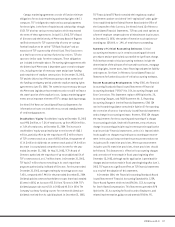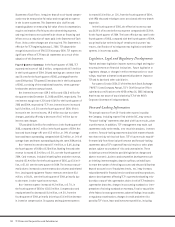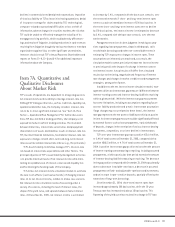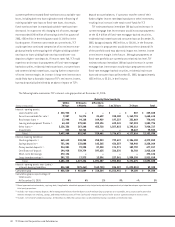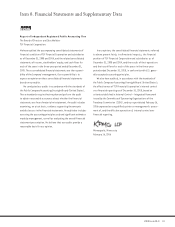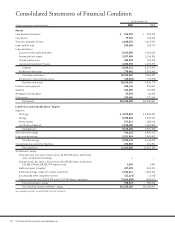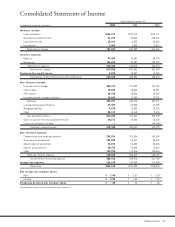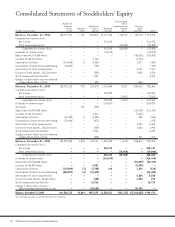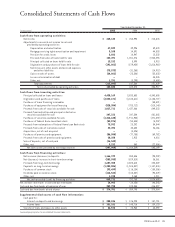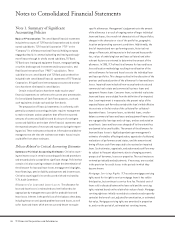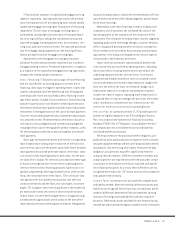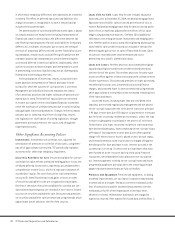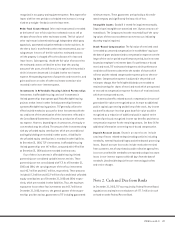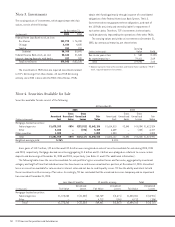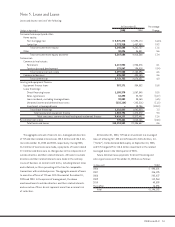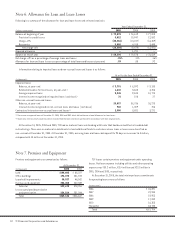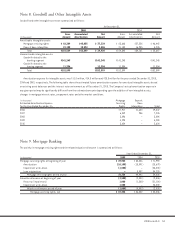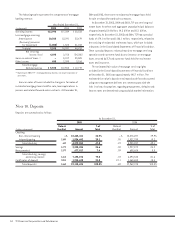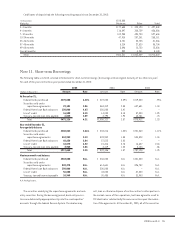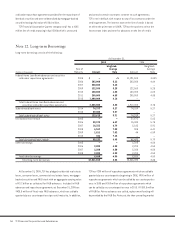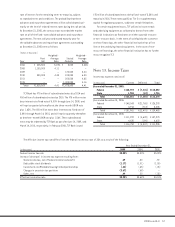TCF Bank 2005 Annual Report Download - page 67
Download and view the complete annual report
Please find page 67 of the 2005 TCF Bank annual report below. You can navigate through the pages in the report by either clicking on the pages listed below, or by using the keyword search tool below to find specific information within the annual report.
472005 Form 10-K
TCF periodically evaluates its capitalized mortgage servicing
rights for impairment. Loan type and note rate are the predomi-
nant risk characteristics of the underlying loans used to stratify
capitalized mortgage servicing rights for purposes of measuring
impairment. The fair value of mortgage servicing rights is
estimated by calculating the present value of estimated future
net servicing cash flows, taking into consideration actual and
expected mortgage loan prepayment rates, discount rates, serv-
icing costs, and other economic factors. The expected and actual
rate of mortgage loan prepayments are the most significant
factors driving the value of mortgage servicing rights.
Adjustments to the mortgage servicing rights valuation
allowance for other than permanent impairment are recorded in
mortgage banking revenues. Permanent impairment is recognized
as a reduction in the capitalized mortgage servicing rights and a
charge to the related valuation allowance.
Lease Financing TCF provides various types of lease financing
that are classified for accounting purposes as either direct
financing, sales-type, leveraged or operating leases. Leases that
transfer substantially all of the benefits and risks of equipment
ownership to the lessee are classified as direct financing or sales-
type leases and are included in loans and leases. Direct financing
and sales-type leases are carried at the combined present value
of the future minimum lease payments and the lease residual value.
Investments in leveraged leases are the sum of all lease payments
(less non-recourse debt payments) plus estimated residual values,
less unearned income. The determination of the lease classifica-
tion requires various judgments and estimates by management
including the fair value of the equipment at lease inception, useful
life of the equipment under lease, and collectability of minimum
lease payments.
Sales-type leases generate dealer profit which is recognized at
lease inception by recording lease revenue net of the lease cost.
Lease revenue consists of the present value of the future minimum
lease payments discounted at the rate implicit in the lease. Lease
cost consists of the leased equipment’s book value, less the pres-
ent value of its residual. The revenues associated with other types
of leases are recognized over the term of the underlying leases.
Interest income on direct financing and sales-type leases is rec-
ognized using methods which approximate a level yield over the
fixed, non-cancelable term of the leases. TCF receives pro-rata
rent payments for the variable interim period until the lease
contract commences and the fixed, non-cancelable, lease term
begins. TCF recognizes these interim payments in the month they
are earned and records the income in interest income on direct
finance leases. Income from leveraged leases is recognized using
a method which approximates a level yield over the term of the
leases based on the unrecovered equity investment. Management
has policies and procedures in place for the determination of lease
classification and review of the related judgments and estimates
for all lease financings.
Additionally, some lease financings include a residual value
component, which represents the estimated fair value of the
leased equipment at the expiration of the initial term of the
transaction. The estimation of residual values involves judgments
regarding product and technology changes, customer behavior,
shifts in supply and demand and other economic assumptions.
These estimates are reviewed at least annually and downward
adjustments, if necessary, are charged to non-interest expense
in the periods in which they become known.
Leases which do not transfer substantially all benefits and
risks of ownership are classified as operating leases. Operating
leases represent a rental agreement where ownership of the
underlying equipment resides with the lessor. Such leased
equipment and related initial direct costs are included in other
assets on the balance sheet and is depreciated on a straight-line
basis over the term of the lease to estimated salvage value.
Depreciation expense is recorded as operating lease expense
in other non-interest expense. Operating lease rental income is
recognized when it is due according to the provisions of the lease
and is recorded as a component of non-interest income. No
reserves for lease losses are carried on operating leases.
Pension Plan As summarized in Note 17, TCF provides pension
benefits to eligible employees in the TCF Cash Balance Pension
Plan. In accordance with Statement of Financial Accounting
Standard (“SFAS”) No. 87 “Employers’ Accounting for Pensions,”
the Company does not consolidate the assets and liabilities
associated with the pension plan.
The measurement of the projected benefit obligation, pre-
paid pension asset and annual pension expense involves complex
actuarial valuation methods and the use of actuarial and economic
assumptions. Due to the long-term nature of the pension plan
obligation, actual results may differ significantly from the
actuarial-based estimates. Differences between estimates and
actual experience are required to be deferred and under certain
circumstances amortized over the future expected working life-
time of plan participants. As a result, these differences are not
recognized when they occur. TCF closely monitors all assumptions
and updates them annually.
Income Taxes Income taxes are accounted for using the asset
and liability method. Under this method, deferred tax assets and
liabilities are recognized for the future tax consequences attrib-
utable to differences between the financial statement carrying
amounts of existing assets and liabilities and their respective
tax bases. Deferred tax assets and liabilities are measured using
enacted tax rates expected to apply to taxable income in the years


